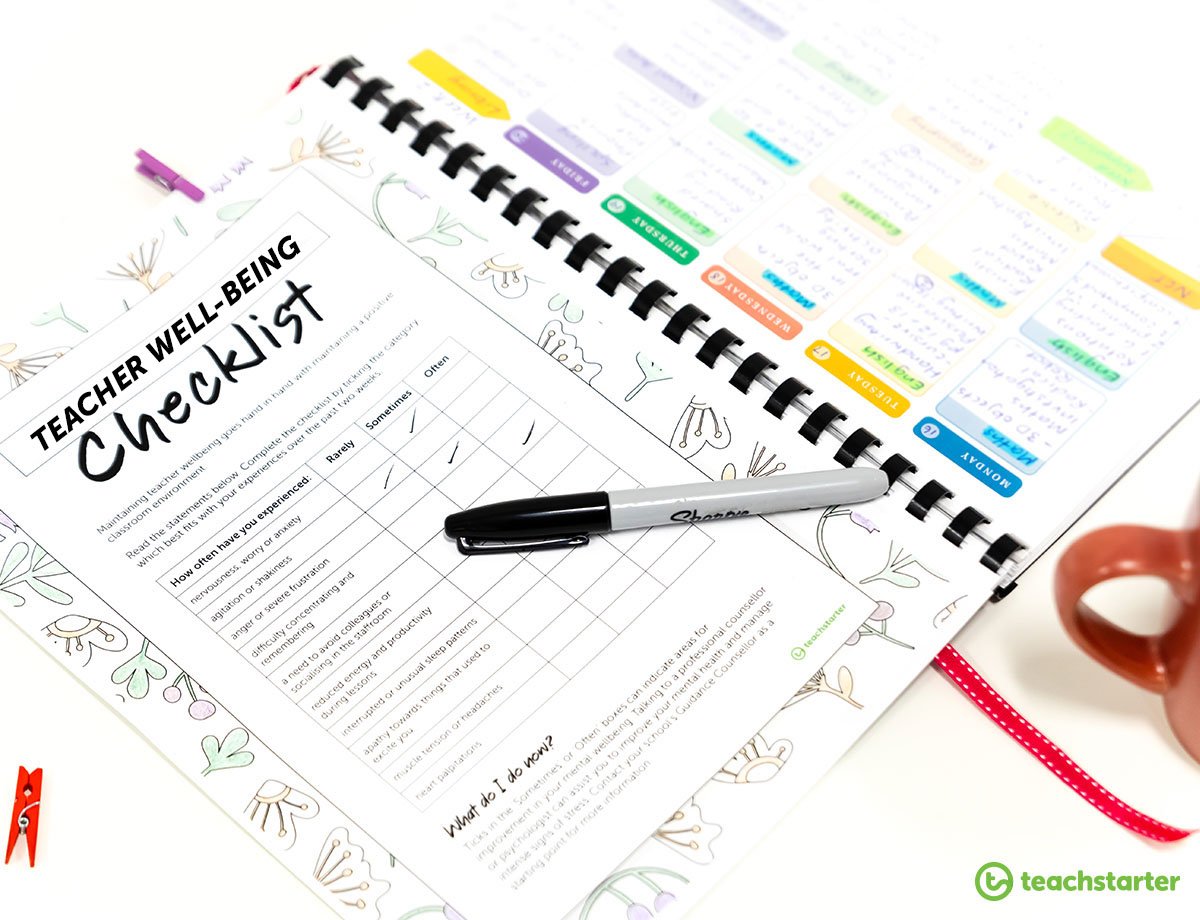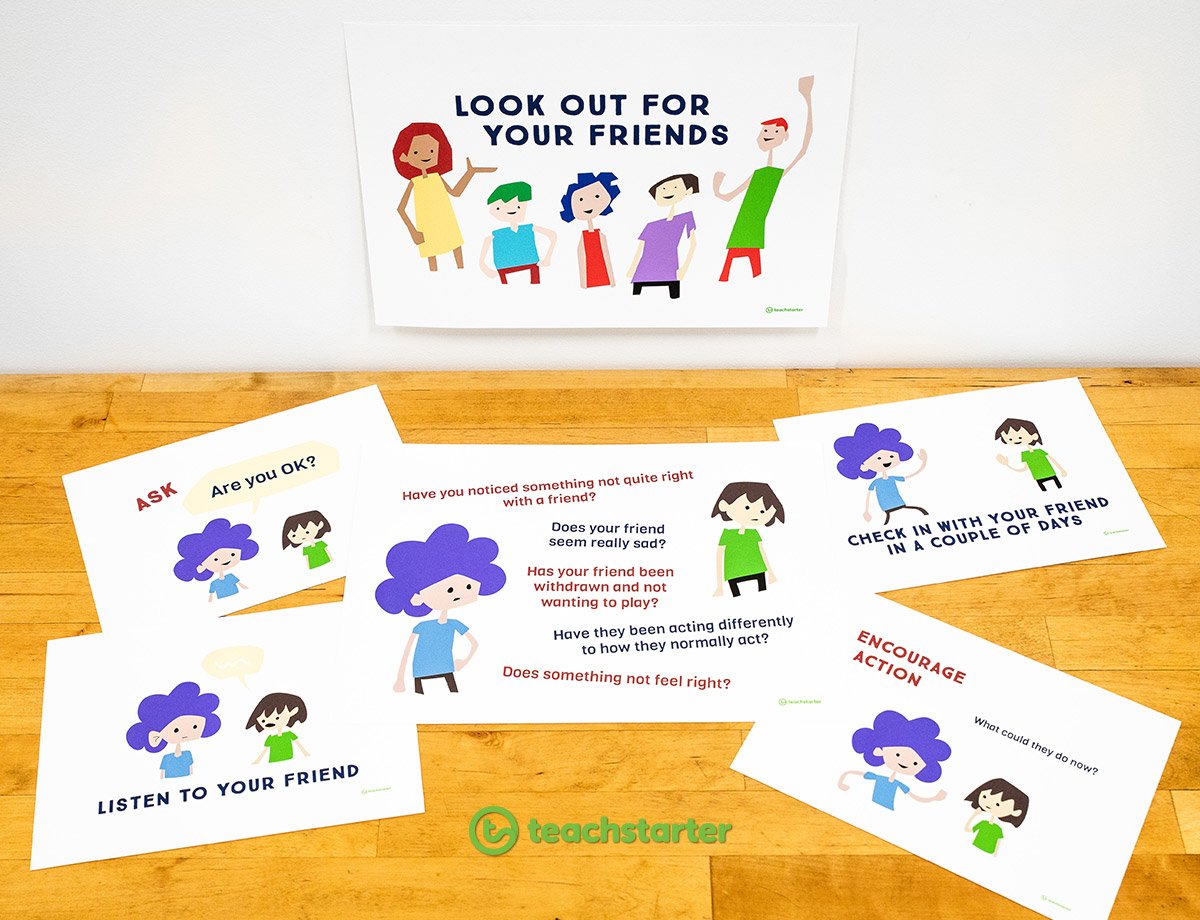The numbers are staggering — as much as 27 percent of teachers have considered leaving the field since the pandemic began. Even without social distancing, masks, and juggling synchronous and asynchronous learning, let’s face it: Teachers do a LOT!
The combination of administrative, classroom, and co-curricular responsibilities in a teacher’s day-to-day life can really add up. By the end of the week, we are often left feeling emotionally and physically spent. It’s no secret that the emotional atmosphere of the classroom affects our students’ learning!
So what are you doing for your mental health? Teacher well-being should be at the forefront of our minds, and for a good reason.
A few years ago, I began to experience frequent panic attacks in the classroom. I would be standing in front of my fourth-grade class and have a racing heart, be short of breath, and feel the urge to tell my (completely undeserving) students to leave me alone and figure things out for themselves. I needed to take stock of my behavior and consider the causes behind my stress. I developed a strategy to manage my mental health more competently.
Recognizing and taking care of your mental health is the perfect way to lay a solid foundation for an emotionally balanced classroom.
Our free Teacher Well-Being Checklist is a great place to start before you begin to feel the impact of mental strain. Putting it into your planner for a monthly or even weekly self-check-in makes for an easy way to monitor your emotional well-being.
Combine it with our free 5 Tips For Teacher Well-Being Poster to encourage positive discussion in your staff room and get on the right track for a mentally healthy workplace!
Taking Stock of Mental Health
As teachers, we often focus on the children’s physical, emotional, and mental well-being in our care. We are nurturers by nature, and teacher well-being often falls off the radar. But it is like oxygen masks in an airplane; only when we take care of ourselves can we fully support those in our classroom.

5 Tips For Teacher Well-Being
We’ve all been there. It’s 2:30 pm on a Friday, and you and your class have pushed yourselves all week. They’re tired, you’re tired, and you’re both counting down the minutes until the bell rings and the weekend begins! The problem is, you have two bags full of grading and planning to complete before Monday.
How can you make sure you achieve all you need without draining every last drop in your mental engine?
Taking some time to take care of yourself during the week can really benefit your long-term productivity and overall mood. Make yourself a cup of coffee (or tea), sit back, and read ahead for some easy ways to take care of yourself.
Take Time to De-Stress
Everyone has their de-stressors, the things that make them instantly relax and feel rejuvenated.
Some ideas for an immediate stress reliever:
- Go for a 10-minute walk.
- Close your eyes and take ten deep breaths.
- Visualize a pleasing scene, like a calm beach or an event that you are looking forward to.
- Take a break from your computer screen or phone.
- Put on soothing music.
- Do some coloring. Studies have shown that repetitive motions (like those used when coloring, cross-stitching, or making jewelry) reduce anxiety. Here are some great ideas and resources for taking mindfulness coloring to the entire classroom!
Take Time to Talk
Talking over issues you are having at work with a colleague or mentor is a great way to resolve a problem. Sometimes just talking about something out loud can help you untangle a tricky issue, and your conversation partner might help you see something from a different point of view! If you don’t feel comfortable talking to someone at work, see if your school has an Employee Assistance Program that can give you an objective ear to talk to.

Work Toward a Good Work/Life Balance
Switch Off Your Email
Being available online 24/7 can open you up to communications that can leave you excited or stressed about work, which can shift the mood of your whole weekend. It’s important to set yourself a ‘switch-off’ time. Ensure that students and their families know that you will not be available but that you’ll get back to them as soon as your work week begins again.
Set Realistic Expectations – It’s OK to Say ‘No’
While teachers are amazing multitaskers, we are also mere humans. People will understand if you do not have time to take on another after-school activity, implement another classroom initiative, or mentor another student teacher. Instead of taking on an overload of work, suggest a colleague who might be happy to improve their experience or impress their supervisor.
Choose One Activity For Yourself A Week
Choosing an activity just for you one day a week can help you disconnect from work stresses. Taking up yoga, calling a friend just to chat, or taking a walk through the neighborhood are all simple ways to decompress from your busy week.
Take Care of your Physical Well-being
Studies have shown a close link between your physical and mental health. Some of the crucial things to take care of include:
- Getting enough sleep. Adults in the 18–65 age bracket need between 7 and 9 hours of sleep a night. A good night’s sleep can boost productivity during the daylight hours so that you’ll be working smarter, not harder.
- Eat a balanced diet. Eating a balanced diet provides your body (including your brain) with the nutrients it needs to function properly. Don’t forget to drink plenty of water!
- Be active. Exercise produces endorphins, which send a boost of positivity to your brain. Research suggests that 30 minutes of moderate to intense physical activity most days of the week can lead to an increase in mental functioning, including an increase in memory and learning ability. If you’re short on time or motivation, break your 30 minutes into 10- or 15-minute intervals.

Practice Mindfulness
If you’re unfamiliar with the concept of mindfulness, it involves actively and intentionally focusing on the present moment – being aware of the things around you and the physical and emotional sensations that your body is experiencing.
Mindfulness is as simple as observing your class and each child without judgment. They don’t have to be perfectly still and quiet for you to do this! Mindfulness is not about being in a completely serene and peaceful environment. It is about finding the calm among the chaos. The benefits of teaching mindfulness to your class include increased focus, reduced stress, and improvement in academic performance.
Our Mindfulness Teaching Resource Pack provides some excellent resources to practice the art of mindfulness in your classroom. At the end of the year, you can even complete our free End of Year Mindful Self Reflection resource to take stock of the past school year and prepare for the next one more mindfully!
[resource:1511990][resource:639405][resource:691655][resource:9744]
Are You ‘Still’ OK?
It’s important to realize that EVERY day can be an opportunity to take stock of the mental health of yourself and those around you!
Check-in with your students, colleagues, and family members regularly to see how they are doing. Open up discussions about your mental health with colleagues and friends to ensure you’re taking care of your well-being and the well-being of those around you.

For a great insight into how to support your own and other’s mental health, listen to The Teach Starter podcast ‘For the Love of Teaching’. Bron has put together a very special episode, ‘World Mental Health Day | Mitch Wallis, Heart on My Sleeve’.
Let’s banish the stigma of mental health and get on the path to a happier, healthier classroom! What steps have you taken to improve your mental health? Comment below to share your experiences!









I find this to be incredibly true. The unplugging piece can be really challenging. I find that this technology has led to some unrealistic expectations for teachers who receive emails and notifications at all hours of the night.
Very true, Alexandra. I find it best to set my phone to Do Not Disturb after a certain time so I don't get notified about all the emails, and have turned off notifications entirely on my phone for work-related apps so I only see things when I go looking for them during work hours!